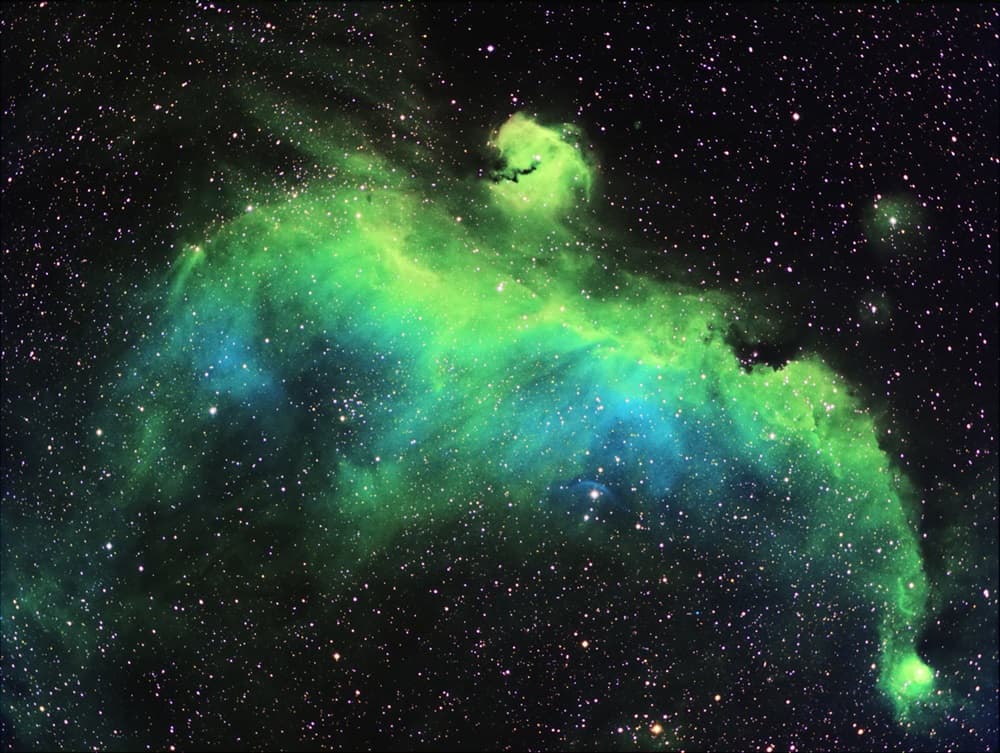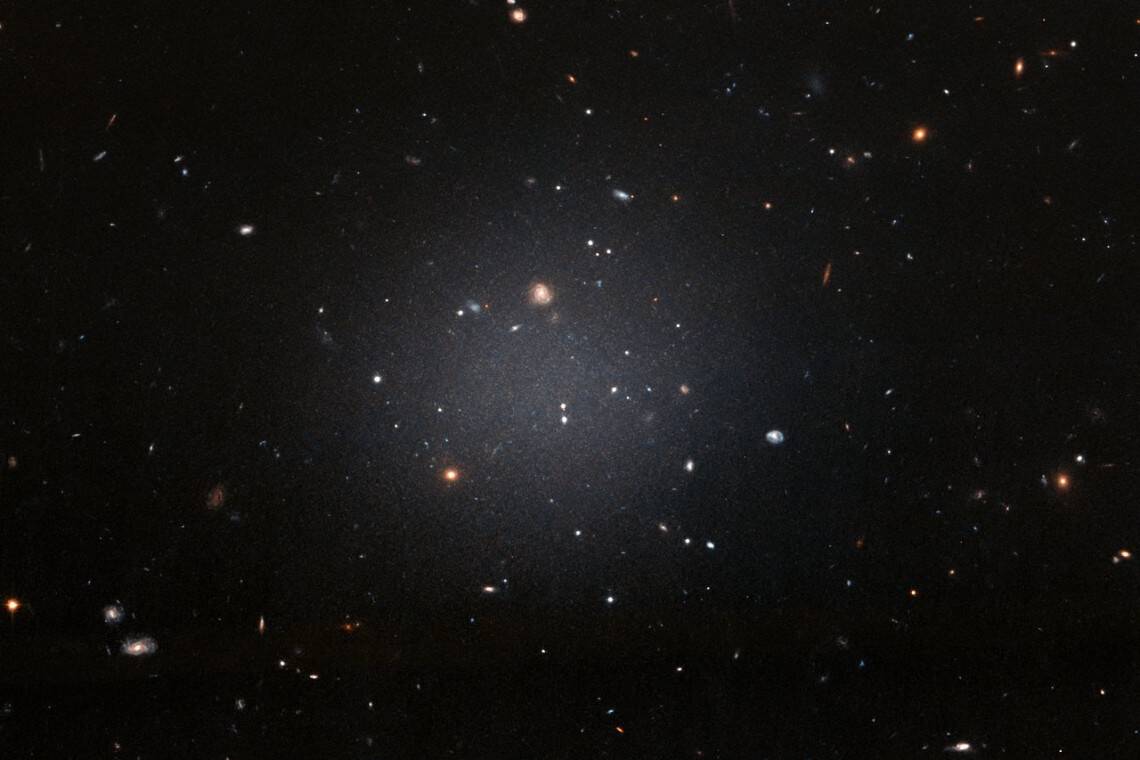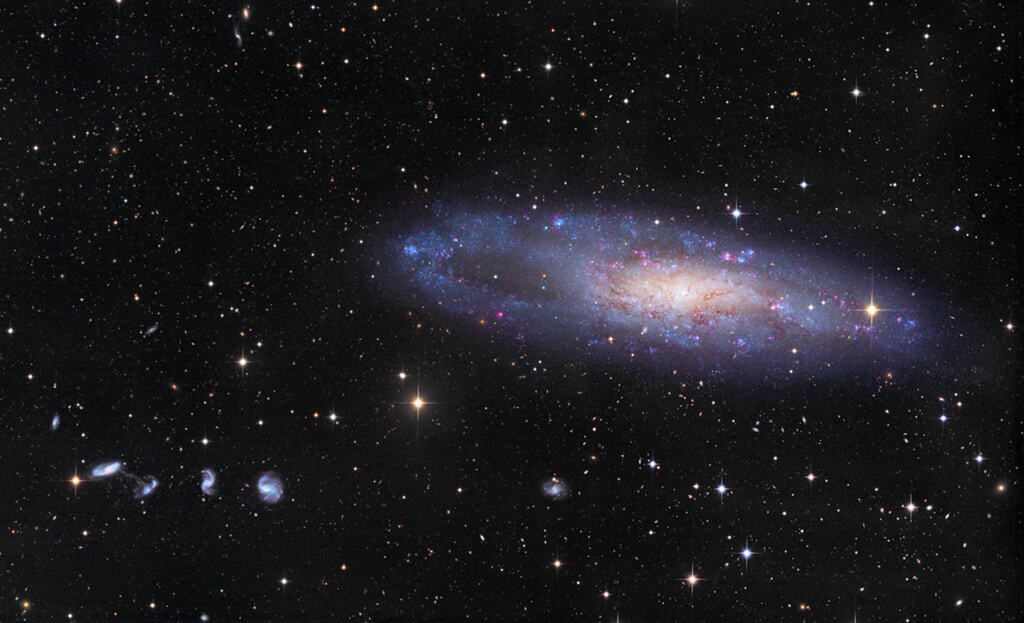Blog
Violin Duet Featured at the Delhi Springtime Indian Music Festival this April 8th.
https://www.youtube.com/watch?v=0D44yfPUkX0
more...IC2177, also called the Seagull Nebula, imaged in several narrowband filters that highlight the true-color green glow of doubly ionized oxygen.
IC 2177 is a region of nebulosity that lies along the border between the constellations Monoceros and Canis Major. It is a roughly circular H II regioncentered on the Be star HD 53367. This nebula was discovered by Welsh amateur astronomer Isaac Roberts and was described by him as “pretty bright, extremely large, irregularly round, very diffuse.”
The name Seagull Nebula is sometimes applied by amateur astronomers to this emission region, although it more properly includes the neighboring regions of star clusters, dust clouds and reflection nebulae. This latter region includes the open clusters NGC 2335 and NGC 2343.
more...
Gilbert “Gil” Scott-Heron (April 1, 1949 – May 27, 2011) was an American soul and jazz poet, musician, and author, known primarily for his work as a spoken-word performer in the 1970s and 1980s. His collaborative efforts with musician Brian Jackson featured a musical fusion of jazz, blues, and soul, as well as lyrical content concerning social and political issues of the time, delivered in both rapping and melismatic vocal styles by Scott-Heron. His own term for himself was “bluesologist”, which he defined as “a scientist who is concerned with the origin of the blues”.
His music, most notably on the albums Pieces of a Man and Winter in America in the early 1970s, influenced and foreshadowed later African-American music genres such as hip hop and neo soul. Scott-Heron is considered by many to be the first rapper/MC ever. His recording work received much critical acclaim, especially one of his best-known compositions, “The Revolution Will Not Be Televised“. AllMusic‘s John Bush called him “one of the most important progenitors of rap music,” stating that “his aggressive, no-nonsense street poetry inspired a legion of intelligent rappers while his engaging songwriting skills placed him square in the R&B charts later in his career.”
more...Irving Sidney “Duke” Jordan (April 1, 1922 – August 8, 2006) was an American jazz pianist.
Jordan was born in New York and raised in Brooklyn where he attended Boys High School. An imaginative and gifted pianist, Jordan was a regular member of Charlie Parker‘s quintet during 1947–48, which also featured Miles Davis. He participated in Parker’s Dial sessions in late 1947 that produced “Dewey Square”, “Bongo Bop”, “Bird of Paradise”, and the ballad “Embraceable You“. These performances are featured on Charlie Parker on Dial.
Jordan had a long solo career from the mid-1950s onwards, although for a period in the mid-1960s he drove a taxi in New York. After periods accompanying Sonny Stitt and Stan Getz, he performed and recorded in the trio format. His most notable composition, “Jordu“, became a jazz standard when trumpeter Clifford Brown adopted it into his repertoire.
Beginning in 1978 he lived in Copenhagen, Denmark, having recorded an extensive sequence of albums for the SteepleChase label; his first record date for the company was in 1973. He was reported not to have changed his style over the course of his career. Some of his best live recordings are available on SteepleChase, or Marshmallow Records, a Japanese label.
more...Alberta Hunter (April 1, 1895 – October 17, 1984) was an American jazz singer and songwriter who had a successful career from the early 1920s to the late 1950s, and then stopped performing. After twenty years of working as a nurse, in 1977 Hunter successfully resumed her popular singing career until her death.
Hunter was born in Memphis, Tennessee, to Laura Peterson, who worked as a maid in a Memphis brothel, and Charles Hunter, a Pullman porter. Hunter said she never knew her father. She attended Grant Elementary School, off Auction Street, which she called Auction School, in Memphis. She attended school until around age 15.
https://www.youtube.com/watch?v=BmFtwwCOmmo
more...Ferro Gaita was founded in 1996 in the city of Praia, the capital of Cape Verde. From the beginning, the band put their own spin on funana, mixing in snare and hand drums, electric bass, and even a conch shell to create a spirited instrumental backing for an upbeat and energetic live show.
more...An international team of researchers using the NASA/ESA Hubble Space Telescope and several other observatories have, for the first time, uncovered a galaxy in our cosmic neighbourhood that is missing most — if not all — of its dark matter. This discovery of the galaxy NGC 1052-DF2 challenges currently-accepted theories of and galaxy formation and provides new insights into the nature of dark matter. The results are published in Nature.
Astronomers using Hubble and several ground-based observatories have found a unique astronomical object: a galaxy that appears to contain almost no dark matter. Hubble helped to accurately confirm the distance of NGC 1052-DF2 to be 65 million light-years and determined its size and brightness. Based on these data the team discovered that NGC 1052-DF2 larger than the Milky Way, but contains about 250 times fewer stars, leading it to be classified as an ultra diffuse galaxy.
“I spent an hour just staring at this image,” lead researcher Pieter van Dokkum of Yale University says as he recalls first seeing the Hubble image of NGC 1052-DF2. “This thing is astonishing: a gigantic blob so sparse that you see the galaxies behind it. It is literally a see-through galaxy.”
Further measurements of the dynamical properties of ten globular clusters orbiting the galaxy allowed the team to infer an independent value of the galaxies mass. This mass is comparable to the mass of the stars in the galaxy, leading to the conclusion that NGC 1052-DF2 contains at least 400 times less dark matter than astronomers predict for a galaxy of its mass, and possibly none at all . This discovery is unpredicted by current theories on the distribution of dark matter and its influence on galaxy formation.
more...Red Norvo (born Kenneth Norville, March 31, 1908 – April 6, 1999) was one of jazz‘s early vibraphonists, known as “Mr. Swing”. He helped establish the xylophone, marimba, and vibraphone as jazz instruments. His recordings included “Dance of the Octopus”, “Bughouse”, “Knockin’ on Wood”, “Congo Blues”, and “Hole in the Wall”.
Red Norvo was born in Beardstown, Illinois. His career began in Chicago with a band called “The Collegians” in 1925. He played with many other bands, including an all-marimba band on the vaudeville circuit, and the bands of Paul Whiteman, Benny Goodman, Charlie Barnet, and Woody Herman. He recorded with Mildred Bailey (his wife), Billie Holiday, Dinah Shore and Frank Sinatra. Norvo and his wife were known as “Mr. and Mrs. Swing.” He appeared as himself in the film Screaming Mimi (1958) and in Ocean’s 11, accompanying Dean Martin while he sang “Ain’t That a Kick in the Head?“.
https://www.youtube.com/watch?v=waJzUxAz4z8
more...Frederick William Green (March 31, 1911 – March 1, 1987) was an American swing jazz guitarist who played rhythm guitar with the Count Basie Orchestra for almost fifty years.
Green was born in Charleston, South Carolina on March 31, 1911. He was exposed to music from an early age, and learned the banjo before picking up the guitar in his early teenage years. A friend of his father by the name of Sam Walker taught a young Freddie to read music, and keenly encouraged him to keep up his guitar playing. Walker gave Freddie what was perhaps his first gig, playing with a local community group with whom Walker was an organizer. Another member of the group was William “Cat” Anderson, who went on to become an established trumpeter, working with notable figures such as Duke Ellington.
more...Etta Baker (March 31, 1913 – September 23, 2006) was an American Piedmont blues guitarist and singer from North Carolina.
She was born Etta Lucille Reid in Caldwell County, North Carolina, of African-American, Native American, and European-American heritage. She began playing the guitar at the age of three. She was taught by her father, Boone Reid, a longtime player of the Piedmont blues on several instruments. He was her only musical instructor. She played both the 6-string and the 12-string acoustic guitar and the five-string banjo. Baker played the Piedmont blues for nearly ninety years.
more...Jaques Murigande, aka Mighty Popo, was born in Ngagara, a neighborhood in Bujumbura, Burundi populated largely by Rwandan and Congolese migrants and refugees.
more...
About 70,000 light-years across, NGC 247 is a spiral galaxy smaller than our Milky Way. Measured to be only 11 million light-years distant it is nearby though. Tilted nearly edge-on as seen from our perspective, it dominates this telescopic field of view toward the southern constellation Cetus. The pronounced void on one side of the galaxy’s disk recalls for some its popular name, the Needle’s Eye galaxy. Many background galaxies are visible in this sharp galaxy portrait, including the remarkable string of four galaxies just below and left of NGC 247 known as Burbidge’s Chain. Burbidge’s Chain galaxies are about 300 million light-years distant. The deep image even reveals that the two leftmost galaxies in the chain are apparently interacting, joined by a faint bridge of material. NGC 247 itself is part of the Sculptor Group of galaxies along with the shiny spiral NGC 253.
more...Norah Jones (born Geetali Norah Shankar; March 30, 1979 Brooklyn, NY) is an American singer, songwriter, pianist and actress. She has won numerous awards and has sold more than 50 million records worldwide. Billboard named her the top jazz artist of the 2000–2009 decade. She has won nine Grammy Awards and was 60th on Billboard magazine’s artists of the 2000–2009 decade chart.
In 2002, Jones launched her solo music career with the release of Come Away with Me, a commercially successful and critically acclaimed album that was a fusion of jazz with country music and pop. It was certified Diamond, selling over 27 million copies. The record earned Jones five Grammy Awards, including the Album of the Year, Record of the Year, and Best New Artist. Her subsequent studio albums Feels Like Home, released in 2004; Not Too Late, released in 2007, and 2009’s The Fall all gained Platinum status, selling over a million copies each. They were also generally well received by critics. Jones’ fifth studio album, Little Broken Hearts, was released on April 27, 2012, and her most recent, sixth studio album, Day Breaks, was released on October 7, 2016. Jones made her film debut in My Blueberry Nights, which was released in 2007.
Jones is the daughter of Indian sitar player and composer Ravi Shankar, and is the half-sister of fellow musician Anoushka Shankar.
more...Eric Patrick Clapton, CBE (born 30 March 1945), is an English rock and blues guitarist, singer, and songwriter. He is the only three-time inductee to the Rock and Roll Hall of Fame: once as a solo artist and separately as a member of the Yardbirds and of Cream. Clapton has been referred to as one of the most important and influential guitarists of all time. Clapton ranked second in Rolling Stone magazine’s list of the “100 Greatest Guitarists of All Time“ and fourth in Gibson’s “Top 50 Guitarists of All Time”. He was also named number five in Time magazine’s list of “The 10 Best Electric Guitar Players” in 2009.
In the mid-1960s Clapton left the Yardbirds to play with John Mayall & the Bluesbreakers. Immediately after leaving Mayall, Clapton formed the power trio Cream with drummer Ginger Baker and bassist Jack Bruce, in which Clapton played sustained blues improvisations and “arty, blues-based psychedelic pop”.After Cream broke up, he formed blues rock band Blind Faith with Baker, Steve Winwood, and Ric Grech. Clapton’s solo career began in the 1970s, where his work bore the influence of the mellow style of J. J. Cale and the reggae of Bob Marley. His version of Marley’s “I Shot the Sheriff” helped reggae reach a mass market. Two of his most popular recordings were “Layla“, recorded with Derek and the Dominos; and Robert Johnson‘s “Crossroads“, recorded with Cream. Following the death of his son Conor in 1991, Clapton’s grief was expressed in the song “Tears in Heaven“, which was featured on his Unplugged album.
more...Astrud Gilberto (born March 29, 1940) is a Brazilian samba and bossa nova singer. She became well known in the 1960s for her performance of the song “The Girl from Ipanema“.
Astrud Gilberto was born Astrud Evangelina Weinert, the daughter of a Brazilian mother and a German father, in the state of Bahia, Brazil. She was raised in Rio de Janeiro. She married João Gilberto in 1959 and emigrated to the United States in 1963, residing in the U.S. from that time. Astrud and João divorced in the mid-1960s and she began a relationship with her musical partner, American jazz saxophone player Stan Getz.
more...World Music of Flamenco Fridays with Daniel Casares.
Una guitarra creada por el #luthier #AntonioBernal que resuena en el taller de la Guitarrería Alvarez & Bernal con estas bulerías, unas bulerías que solo Daniel Casares sabe tocar así.
more...Through the Fire I Come
https://www.youtube.com/watch?v=LNBxFZQl3oo&index=10&list=PLEB3LPVcGcWZ0hsQ5_jgSMhawAnDzy1io
more...More Posts
- Cosmos M24
- Freddie Hubbard
- Ravi Shankar
- Mongo Santamaría
- Billie Holliday
- FREE UKRAINE World Music ONUKA
- Daily Roots Ijahman Levi
- Cosmos M81
- John Pizzarelli
- Randy Weston
- Charlie Rouse
- Art Taylor
- Big Walter Horton
- SUPPORT UKRAINE World Music Baltvilks
- Daily Roots Blackjahman
- Cosmos Vortex Aurora
- Stanley Turrentine
- Stan Levey
- Billy Bland
- FREE UKRAINE World Music Veseli Vujky


